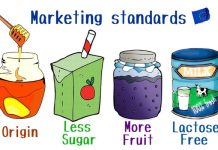The web and mainstream media, including Corriere della sera and Repubblica, are today recalling the event of the day. World Nutella Day, Feb. 5, a global day dedicated to Ferrero’s spreadable cream. A purely commercial initiative with such an impact on children’s nutrition that it is the subject of new scientific research from the University of Liverpool, just published in theInternational Journal of Environmental Research and Public Health. (1)
British researchers had already shown in mid-2019 that children’s exposure to influencers ‘ marketing of junk food on YouTube increases immediate consumption of foods and beverages high in fat, sugar, and salt (HFSS). (2) As also noted in other previous studies, which we have already reported on. In the new study they analyze the persuasion mechanisms used by bloggers and the reaction of children.
The World Nutella Day case study
The researchers showed a group of 24 subjects (half female) aged 10-11 years part of a video posted in 2018 on YouTube by a 20-year-old British man anointed as an influencer by 11 million users on three different channels on the platform.
In the Nutella Breakfast Party film, the young man reports that he was hired by Ferrero to make a video communicating how to celebrate ‘World Nutella Day.’ He shows a stool received as a gift from Ferrero. And it launches a contest for viewers, with three jars of Nutella up for grabs among those who share the video on Instagram and Twitter with the hastag #WorldNutellaDay.
La
location
of the video is a beautiful, bright, well-appointed house, overlooking a manicured lawn and ‘sweetened’ by the presence of a puppy dog, as well as numerous jars of Nutella. Four family members and the YouTuber’s girlfriend (also an influencer) participated, all of whom were photographed in shots to share on social media. At first, #AD appears for 10 seconds, as mandated by UK regulations to highlight content sponsorship on social media.
At the end of the video, viewer engagement is encouraged by theinfluencer, who asks viewers to share ideas, images and videos of how World Nutella Day will be celebrated by each person via the hashtag ‘#WorldNutellaDay’ and to tag the YouTuber on Instagram and Twitter. Viewers are also asked to like the video and subscribe to the YouTuber’s channel.
The reaction of the little spectators
The impact of Operation World Nutella Day was evaluated by British researchers, through interviews with children, to understand the degree to which young children were aware of being targeted by a marketing event and their perceptions of the video blogging platform.
Analysis of the interviews revealed some recurring aspects in the experience of children who routinely consume the content of video bloggers. In general terms, YouTube bloggers fill the gap in children’s lives. Namely, according to the responses rendered by the children,
– Provide content that makes it possible to never get bored,
– allow all kinds of interests to be shared (a passion for dinosaurs, for example),
– allow ‘access’ to forbidden experiences (risky performance, for example, or expensive),
– offer useful information, such as how a newly released game works.
Bloggers are perceived as ordinary people, friends. An illusory feeling of closeness, on the other hand, absent with respect to the traditional celebrities (actors, singers or famous sportsmen, for example) featured in TV commercials. As a result, ‘followed’ bloggers are also seen as trustworthy and disinterested, thus a source of independent information, even when blatantly engaged in marketing.
After watching the video excerpt on World Nutella Day, when asked about their awareness of being the target of a marketing operation, some children gave very lucid answers. Recognizing that to share photos of new recipes and try to win a jar of Nutella, viewers would first have to buy Ferrero’s cream. Very likely outcome, considering that as with all HFSS foods, a jar of Ferrero cream is inexpensive, and the expense is worth the gamble of responding to theinfluencer‘s invitation.
Most respondents, however, did not grasp the commercial essence of the video. To the question ‘Why is Alfie asking viewers to share recipes using the hashtag World Nutella Day?‘, there were terribly naive responses, along the lines of ‘Probably to get more recipes for Nutella‘ (boy, 11 years old) or ‘To see what you (the viewer) can do with Nutella‘ (10-year-old girl).
The study, according to the researchers, confirms the need to reduce children’s exposure to marketing carried by influencers on social media. And it reveals the urgency of protecting the little ones by providing more restrictive measures for influencer marketing to the under-13s.
The charge of junk food in social networks
YouTube is among the most popular social media among the very young. (3) Although a minimum age of 13 is formally required to open an account, no effective control is operated on the registration of new users. Just by changing your date of birth, you can gain unlimited access to the platform with a personal account, which allows you to interact with other users, influencers first and foremost.
In fact, the biggest attraction for children are video bloggers or bloggers on YouTube (YouTubers). People who create and share videos, often advertising (sneakily) food and drink in exchange for gifts or pay. The protagonists of this content are called influencers, and they implement precise marketing techniques(influencer marketing) that are increasingly pervasive. With investment estimated to grow exponentially, from $500 million in 2018 to $5-10 billion in 2023.
After all, the effectiveness of influencer marketing is well established. Children cannot stand pop-up ads (the temporary windows) because they interrupt the enjoyment of the content they are following. They are disinclined to be seduced by traditional testimonials, with whom they are unfamiliar. Instead, they appreciate bloggers, who in videos pretend to tell about themselves, winning the trust of users and allowing them to interact, through likes and comments, consolidating the idea of friendship, of belonging to the group. A valuable liason, to convey publicity.
Globesity
The advertising budgets of global junk-food brands continue to foment globesity, that is, the global epidemic crisis of childhood obesity and related diseases ( NCDs, Non-Communicable Diseases). With solicitation techniques that-as seen in the recent study on Coca-Cola-would merit class actions against the Corporations.
In 2017, more than £300 million was spent on advertising HFSS products in the UK alone. 20 times what was spent in the same year on promoting fruits and vegetables (16 million pounds).
Special rules are needed to protect the health of young people from the risks associated with advertising exposure to junk food and alcoholic beverages. Rules that the WHO has long been calling for and the European institutions-as we have repeatedly denounced-are stubbornly failing to introduce. And the European Commission is 11 years late in establishing nutrient profiles on the basis of which limits on health claims on junk food should be introduced in the first place.
Marta Strinati and Dario Dongo
Notes
(1) Anna Elizabeth Coates, Charlotte Alice Hardman, Jason Christian Grovenor Halford, Paul Christiansen and Emma Jane Boyland. ‘It’s Just Addictive People That Make Addictive Videos’: Children’s Understanding of and Attitudes toward Influencer Marketing of Food and Beverages by YouTube Video Bloggers. (2020) Int. J. Environ. Res. Public Health; https://doi.org/10.3390/ijerph17020449
(2) Anna Elizabeth Coates, Charlotte Alice Hardman, Jason Christian Grovenor Halford, Paul Christiansen, Emma Jane Boyland. The effect of influencer marketing of food and a “protective” advertising disclosure on children’s food intake. (2019) Pediatric Obesity https://doi.org/10.1111/ijpo.12540
(3) About 72% of people aged 10 to 12 in Australia, 85% of people aged 13 to 17 in the United States, and 80% of people aged 5 to 15 in the United Kingdom use YouTube.









